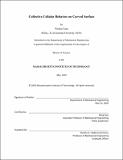| dc.contributor.advisor | Ming Guo. | en_US |
| dc.contributor.author | Tang, Wenhui,S.M.Massachusetts Institute of Technology. | en_US |
| dc.contributor.other | Massachusetts Institute of Technology. Department of Mechanical Engineering. | en_US |
| dc.date.accessioned | 2020-09-03T17:47:28Z | |
| dc.date.available | 2020-09-03T17:47:28Z | |
| dc.date.copyright | 2020 | en_US |
| dc.date.issued | 2020 | en_US |
| dc.identifier.uri | https://hdl.handle.net/1721.1/127112 | |
| dc.description | Thesis: S.M., Massachusetts Institute of Technology, Department of Mechanical Engineering, May, 2020 | en_US |
| dc.description | Cataloged from the official PDF of thesis. | en_US |
| dc.description | Includes bibliographical references (pages 63-66). | en_US |
| dc.description.abstract | Organ surface is tiled by a confluent monolayer of epithelial or endothelial cells, thus providing a physical barrier to the external environment. Cells on these confluent layers often remain static and non-migratory. However, they can also undergo active structural rearrangements during basic physiological processes such as embryonic development, tissue repair as wells as tumor metastasis. While most of existing research of collective cellular behavior are on flat two dimensional (2D) space, most native biological systems however are intrinsically curved, including mature respiratory bronchioles, alveoli, and embryonic tissues. There are fundamental reasons to suspect that such curved geometries will alter collective cellular dynamics in a nontrivial manner. In particular, as the radius of curvature decreases, it inevitably affects packing of objects on the surface. | en_US |
| dc.description.abstract | Furthermore, cells on curved surfaces can generate significant out-of-plane force while developing anisotropic cytoskeletal organization. Yet the role of curvature to collective cellular behavior is underestimated and relatively unknown. In this thesis, we aim to answer two questions: (1) How does the substrate curvature affect collective cell migration; (2) the mechanism of cells packing on sphere as a soft, active material. Different from previous studies, we applied a full set of methods to describe collective cellular behavior and interpreted the phenomenon from a statistical physics perspective. First, we analyzed the individual cell migration properties; density, velocity, and mean square displacement (MSD) are discussed. Next, we explored how cells group themselves as they collectively migrate, in particular how these collective behaviors react to the variation of curvature. Briefly, velocity spatial correlation and correlation length are calculated. | en_US |
| dc.description.abstract | Then in order to give a complete description of migration, collective migration velocity field is decomposed into divergence, curl and shear. Different magnitude and pattern size were observed on different curvatures. Results suggest that cells are able to 'sense' curvature in a collective manner rather than by individual cells. As a further exploration, we tested a more natural system, 'alveolosphere', derived from the human induced Pluripotent stem cells (iPSCs) in a three-dimensional (3D) environment. Similar results are observed that confirms our analysis. We anticipate that these novel findings will offer fundamental insights into the physical basis of embryonic development and tumor invasion, as well as providing insight into how the packing and migration of cells underlie tissue morphogenesis. | en_US |
| dc.description.statementofresponsibility | by Wenhui Tang. | en_US |
| dc.format.extent | 66 pages | en_US |
| dc.language.iso | eng | en_US |
| dc.publisher | Massachusetts Institute of Technology | en_US |
| dc.rights | MIT theses may be protected by copyright. Please reuse MIT thesis content according to the MIT Libraries Permissions Policy, which is available through the URL provided. | en_US |
| dc.rights.uri | http://dspace.mit.edu/handle/1721.1/7582 | en_US |
| dc.subject | Mechanical Engineering. | en_US |
| dc.title | Collective cellular behavior on curved surface | en_US |
| dc.type | Thesis | en_US |
| dc.description.degree | S.M. | en_US |
| dc.contributor.department | Massachusetts Institute of Technology. Department of Mechanical Engineering | en_US |
| dc.identifier.oclc | 1191836225 | en_US |
| dc.description.collection | S.M. Massachusetts Institute of Technology, Department of Mechanical Engineering | en_US |
| dspace.imported | 2020-09-03T17:47:27Z | en_US |
| mit.thesis.degree | Master | en_US |
| mit.thesis.department | MechE | en_US |
